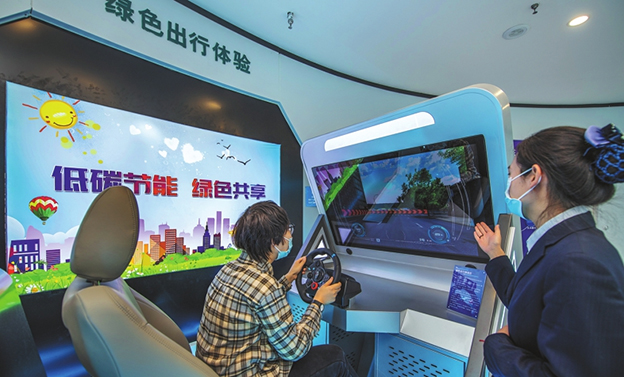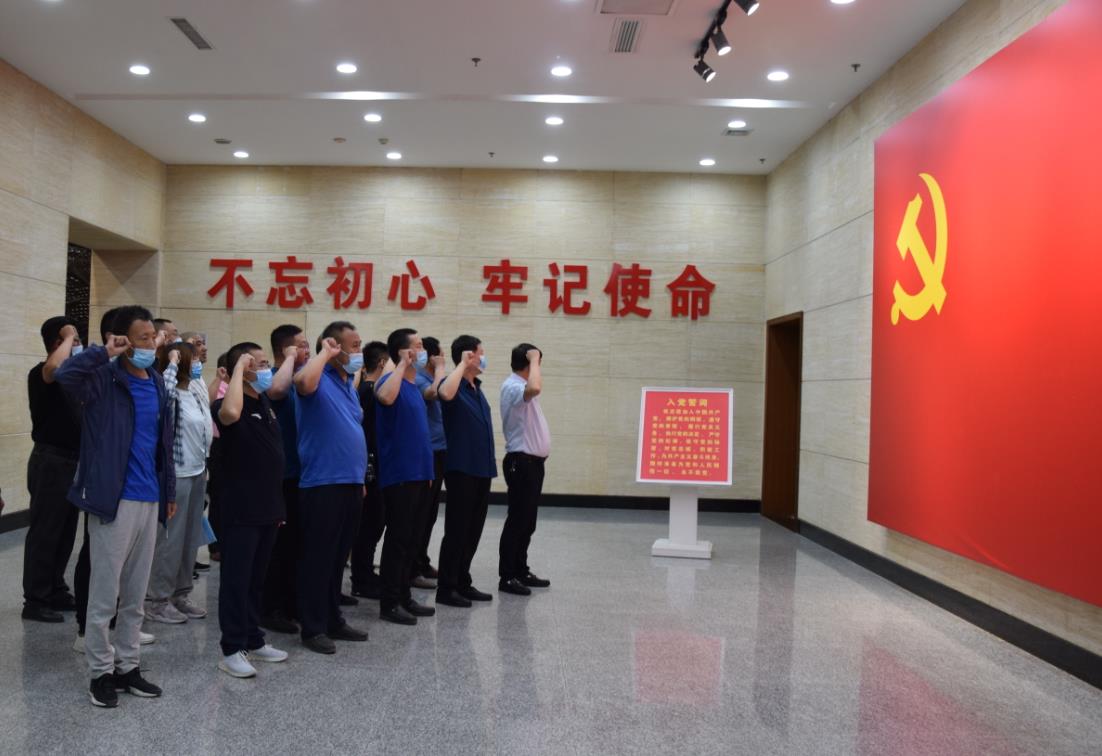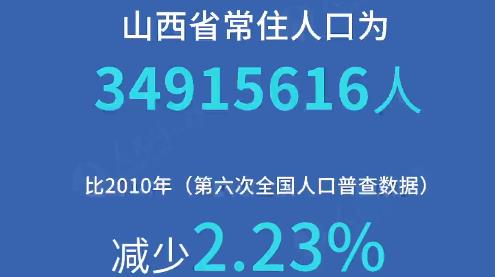
A resident of Yuncheng tries out a driving simulator during a show for intelligent traffic management in the city. XUE JUN / FOR CHINA DAILY
Backed by the new generation of information technologies, North China's Shanxi province has stepped up the development of smart government services in various regions, in a bid to strengthen civil management and improve quality of life.
Residents have experienced the convenience brought by intelligent technologies in fields ranging from government services to healthcare.
The Shanxi e-Government platform, which is known as "sanjintong" among locals, is a smart administration platform launched by the Shanxi provincial government.
The platform can be accessed via apps on computers and smartphones, allowing residents, businesspeople and tourists to receive various public services online.
Wang Dan, a resident in Taiyuan, recently experienced the convenience brought by the platform.
"I had a trip to Kunming, Yunnan province, several days ago," Wang said.
"But when I arrived at the airport, I realized I left my ID card at home.
"My first reaction was that I needed to return home to get the card and transfer to a later flight.
"However, an airport staff member told me that I can apply for a temporary ID card through the Shanxi e-Government platform, which is also valid for travel," Wang said, adding the process only took him several minutes.
According to Li Helin, deputy chief of the Shanxi Administrative Services Bureau, the organization responsible for the platform's operation, the platform can handle more than 1,400 service items in 23 areas ranging from social security, legal service and healthcare to education.
"Since its launch a year ago, the platform currently has 15.58 million users and has received more than 10 million visits for handling public service-related affairs," Li said.
In Shanxi, the online government and public service initiative is not limited to the provincial level and has spread to many governments at local levels.
Liu Tianping, a resident in Jincheng, a city in southeastern Shanxi, was detected with some lung disease symptoms when having a medical examination at a local hospital.
Doctors suggested she consult experts in top hospitals in the provincial capital of Taiyuan through a online public service platform launched by the city government of Jincheng.
"Through the platform, I was able to send my physical examination documents to doctors in Taiyuan, who gave me diagnoses and solutions online," Liu said. "I didn't expect to get services from experts in Taiyuan so easily, even without leaving home."
In Yangquan, intelligent technologies were used in central heating supply this winter.
The city has established a smart operational center for heating, with every switching station linked through a 5G network.
"We can receive real-time data for supplying and returning water temperatures, water volume and heating areas from every switching station and give them accurate instructions for temperature and volume control," said a staff member at the center. "This makes sure that residents are offered the best service while improving efficiency and saving energy in heat supply."Online government services provide convenience
2021-03-19 YUAN SHENGGAO
A resident of Yuncheng tries out a driving simulator during a show for intelligent traffic management in the city.
Backed by the new generation of information technologies, North China's Shanxi province has stepped up the development of smart government services in various regions, in a bid to strengthen civil management and improve quality of life.
Residents have experienced the convenience brought by intelligent technologies in fields ranging from government services to healthcare.
The Shanxi e-Government platform, which is known as "sanjintong" among locals, is a smart administration platform launched by the Shanxi provincial government.
The platform can be accessed via apps on computers and smartphones, allowing residents, businesspeople and tourists to receive various public services online.
Wang Dan, a resident in Taiyuan, recently experienced the convenience brought by the platform.
"I had a trip to Kunming, Yunnan province, several days ago," Wang said.
"But when I arrived at the airport, I realized I left my ID card at home.
"My first reaction was that I needed to return home to get the card and transfer to a later flight.
"However, an airport staff member told me that I can apply for a temporary ID card through the Shanxi e-Government platform, which is also valid for travel," Wang said, adding the process only took him several minutes.
According to Li Helin, deputy chief of the Shanxi Administrative Services Bureau, the organization responsible for the platform's operation, the platform can handle more than 1,400 service items in 23 areas ranging from social security, legal service and healthcare to education.
"Since its launch a year ago, the platform currently has 15.58 million users and has received more than 10 million visits for handling public service-related affairs," Li said.
In Shanxi, the online government and public service initiative is not limited to the provincial level and has spread to many governments at local levels.
Liu Tianping, a resident in Jincheng, a city in southeastern Shanxi, was detected with some lung disease symptoms when having a medical examination at a local hospital.
Doctors suggested she consult experts in top hospitals in the provincial capital of Taiyuan through a online public service platform launched by the city government of Jincheng.
"Through the platform, I was able to send my physical examination documents to doctors in Taiyuan, who gave me diagnoses and solutions online," Liu said. "I didn't expect to get services from experts in Taiyuan so easily, even without leaving home."
In Yangquan, intelligent technologies were used in central heating supply this winter.
The city has established a smart operational center for heating, with every switching station linked through a 5G network.
"We can receive real-time data for supplying and returning water temperatures, water volume and heating areas from every switching station and give them accurate instructions for temperature and volume control," said a staff member at the center. "This makes sure that residents are offered the best service while improving efficiency and saving energy in heat supply."rport staff member told me that I can apply for a temporary ID card through the Shanxi e-Government platform, which is also valid for travel," Wang said, adding the process only took him several minutes.
According to Li Helin, deputy chief of the Shanxi Administrative Services Bureau, the organization responsible for the platform's operation, the platform can handle more than 1,400 service items in 23 areas ranging from social security, legal service and healthcare to education.
"Since its launch a year ago, the platform currently has 15.58 million users and has received more than 10 million visits for handling public service-related affairs," Li said.
In Shanxi, the online government and public service initiative is not limited to the provincial level and has spread to many governments at local levels.
Liu Tianping, a resident in Jincheng, a city in southeastern Shanxi, was detected with some lung disease symptoms when having a medical examination at a local hospital.
Doctors suggested she consult experts in top hospitals in the provincial capital of Taiyuan through a online public service platform launched by the city government of Jincheng.
"Through the platform, I was able to send my physical examination documents to doctors in Taiyuan, who gave me diagnoses and solutions online," Liu said. "I didn't expect to get services from experts in Taiyuan so easily, even without leaving home."
In Yangquan, intelligent technologies were used in central heating supply this winter.
The city has established a smart operational center for heating, with every switching station linked through a 5G network.
"We can receive real-time data for supplying and returning water temperatures, water volume and heating areas from every switching station and give them accurate instructions for temperature and volume control," said a staff member at the center. "This makes sure that residents are offered the best service while improving efficiency and saving energy in heat supply."
Li Shu contributed to this story.
By YUAN SHENGGAO
 山西路桥:党建引领 建好“四好农村路”山西路桥建设集团党委扎实开展“党建质量提升年”,实施“六大工程”,立足“十四五”高质量、高速度、高效益发展的战略基点,全面提高党建质量和党建引领发展水平,为打造“国内一流的交通基础设施投资、建设、施工现代化企业集团”提供坚强政治保障。
山西路桥:党建引领 建好“四好农村路”山西路桥建设集团党委扎实开展“党建质量提升年”,实施“六大工程”,立足“十四五”高质量、高速度、高效益发展的战略基点,全面提高党建质量和党建引领发展水平,为打造“国内一流的交通基础设施投资、建设、施工现代化企业集团”提供坚强政治保障。
 常住人口3491万 山西人口普查数据"出炉"山西省统计局向社会通报山西省第七次全国人口普查主要数据。数据显示,山西省常住人口为34915616人,比2010年(第六次全国人口普查数据,下同)减少2.23%,年平均减少0.23%。山西省常住人口总量减少,主要受人口流动变化等因素影响。
常住人口3491万 山西人口普查数据"出炉"山西省统计局向社会通报山西省第七次全国人口普查主要数据。数据显示,山西省常住人口为34915616人,比2010年(第六次全国人口普查数据,下同)减少2.23%,年平均减少0.23%。山西省常住人口总量减少,主要受人口流动变化等因素影响。